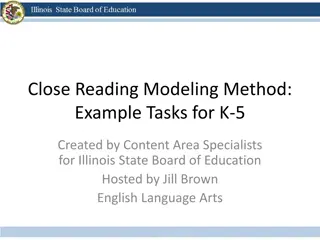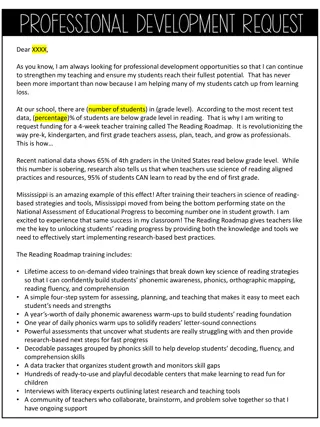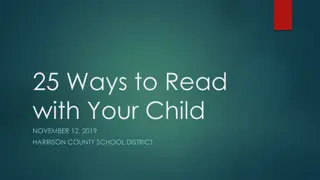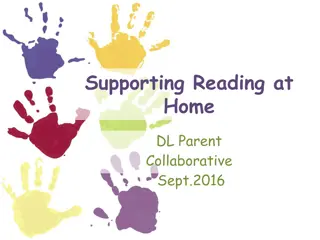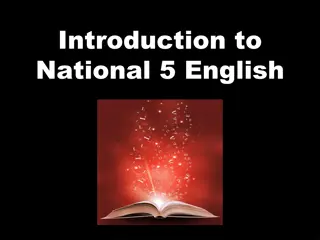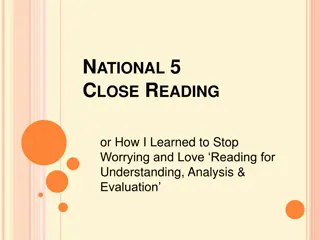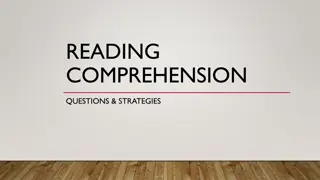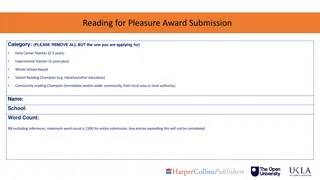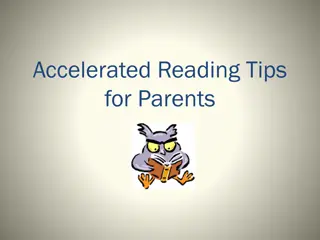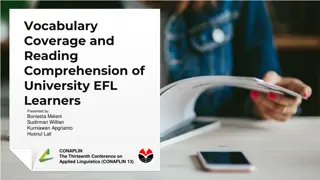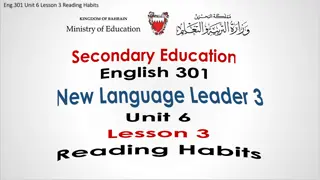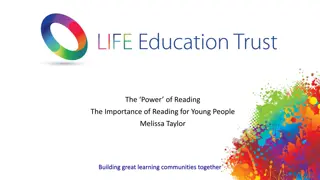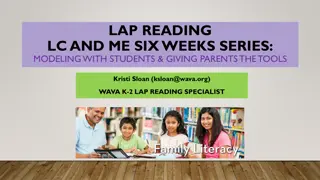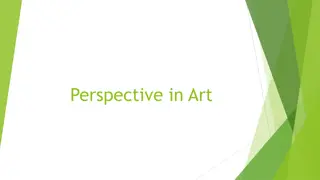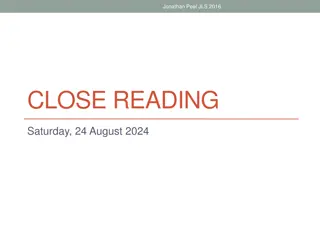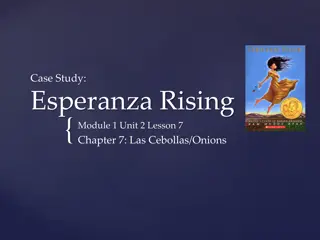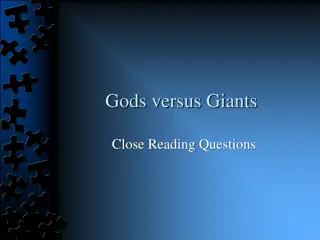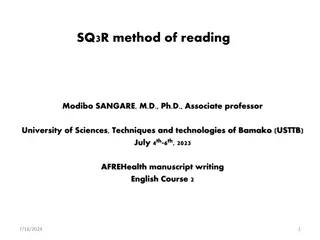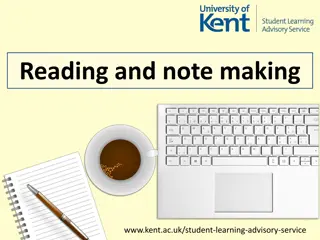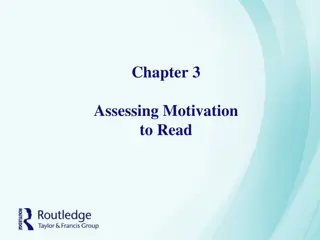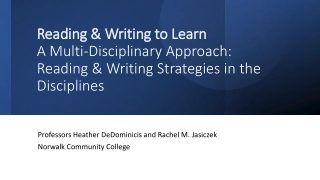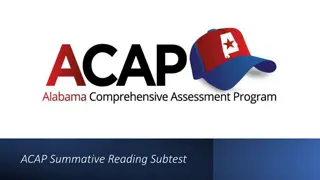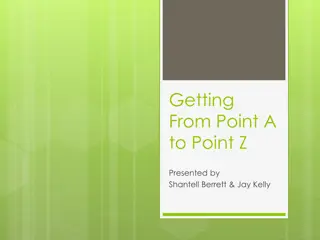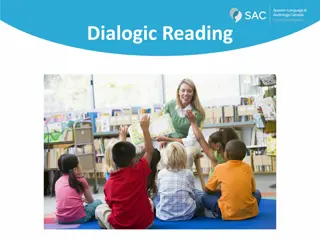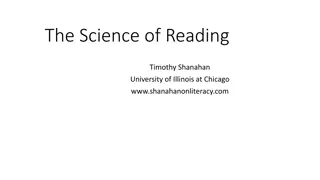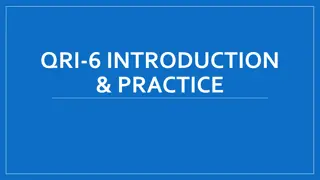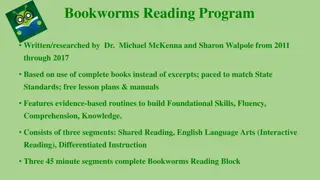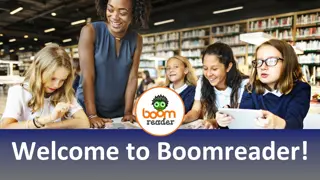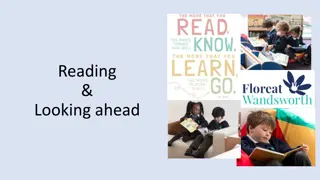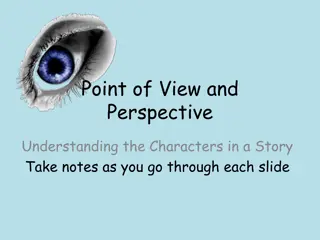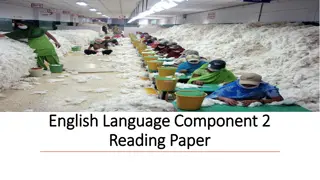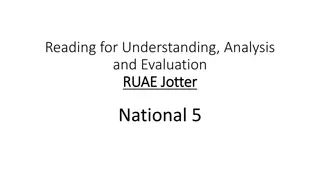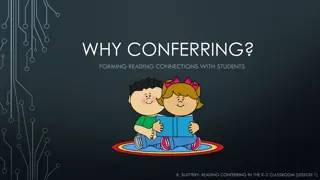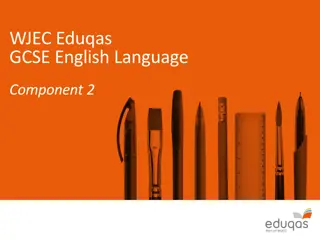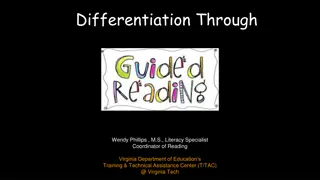Understanding Close Reading: A Historical Perspective
Close reading is not just a teaching technique; it is a goal focused on helping children read texts closely. This approach involves analyzing texts deeply to derive meaning directly from the content, without relying heavily on external sources. With roots in history, close reading has evolved to challenge traditional instructional methods, promoting a more critical and unified approach to reading comprehension.
Download Presentation

Please find below an Image/Link to download the presentation.
The content on the website is provided AS IS for your information and personal use only. It may not be sold, licensed, or shared on other websites without obtaining consent from the author. Download presentation by click this link. If you encounter any issues during the download, it is possible that the publisher has removed the file from their server.
E N D
Presentation Transcript
Close Reading Timothy Shanahan University of Illinois at Chicago www.shanahanonliteracy.com
CCSS set a new comprehension goal Close reading is not a teaching technique It is a goal, a desired outcome: we want our children to be able to read text closely; we want them to be close readers
Poor interpretations of close reading Close reading is not a teaching technique or method Close reading is not a synonym for reading comprehension Close reading is not about thorough reading of text or literal reading comprehension Close reading is not about annotation Close reading is not about citing text evidence Close reading is in your standards, but not where you think it is
In close reading, the meaning is in the text Close reading is a particular approach to reading that some readers use or use some of the time Readers grasp meaning by reading and analyzing a text Close reading is heavily involved in determining the meaning and value of a text through a deep reading of that text with little recourse to other sources of information Close reading treats the text as a unity that means it considers not only the author s message, but how the ways of telling the message reinforce or extend its meaning
Close reading has a long history It starts with the Protestant Reformation 500 years ago Martin Luther dueled with the Church about whether priests were the only ones who could read the Bible This argument reignites in the 1920s and 30s in English Departments Scholasticism: professors/teachers taught the meaning of text based on its creation (e.g., biography, literary movement, historical period) New Criticism (I.A. Richards, C. Brooks & R. P. Warren, etc.): The meaning is in the text and the text must be read closely to get it to give up its meaning
History is important Close reading comes out of an effort to push back against scholasticism/historicism Now that it is being promoted at elementary school level, it appears that it is pushing back against ways that we have been teaching reading There are contradictions between close reading and some common instructional methods, but it is more complicated than that requires closer intentional analysis Remember: During the 1950s-1960s close reading was the major way of reading literature taught in US secondary schools and it was later dropped let s not make the same mistakes
Different historical antecedents Scholasticsm Close Reading Guided Reading College students/adults College students/adults School children Authenticity, historical social context, etc. Hidden meanings, doubleness, symbolism, craft, juxtaposition, Reading comprehension Considering text in context of other texts of and the times/events that produced this text By focusing entirely on the text as a unity which explanation accounts for the most information By decoding, learning vocabulary, learning to connect the text with prior knowledge, attention focusing strategies
Synonyms Not Synonyms Deep reading Thorough reading Analytical reading Literal reading Critical reading Comprehension Being able to answer good questions Annotating Text Citing text evidence Close Reading
Recent problems In many commercial programs, close reading seems to be about answering discrete questions and identifying text evidence that supports their answers (rather than on developing a coherent interpretation of a text that is dependent on text evidence) Just asking kids to find the source of evidence is valuable and yet does not make for a close reading We re overdoing text evidence Some close reading schemes seem to be mainly about marking up texts and coding information (some of that can be useful), but that doesn t have much to do with close reading
Close reading and CCSS Only mentioned once in the standards: Anchor standards: Read closely to determine what the text says explicitly and to make logical inferences from it; cite specific textual evidence when writing or speaking to support conclusions drawn from the text. But the three interpretive goals are built into the DNA of the standards: Key ideas and details Craft and structure Integration of knowledge and meaning
Many versions of close reading In all versions of close reading the meaning is hidden in the text (e.g., through symbolism, irony, double meanings) and needs to be acquired through careful and thorough analysis and re-analysis (texts don t just give up their meaning) Version presented by David Coleman, the architect of the common core standards
Adler and Van Dorens Close Reading Great books (challenging books) need to be read and reread Each reading aims to accomplish a separate purpose The first reading should allow the readers to determine what a text says The second reading should allow them to determine how a text works The third (or fourth) reading should allow the reader to determine the value of the text by evaluate its quality connecting to other texts
Close Reading All focus on text meaning Limited background preparation/explanation Students do the reading/interpretation Teacher s ask text dependent questions that guide student attention towards key text points Multi-day commitment to texts Purposeful rereading (not practice, but separate journeys) Short reads Note-taking, notation
Planning for Close Reading Not all texts lend themselves to deep reading Select high quality text that is worth reading and rereading This means text that has valuable content or themes, layers of meaning, symbolism, etc. Teachers must closely read the text themselves before the students do
Pre-reading What counts as pre-reading? Explorations of prior knowledge Teacher purpose setting Contextualizing the text Text previews What doesn t count as pre-reading? Decoding preparation Vocabulary teaching*
What about Words? Teaching vocabulary or immediately relevant decoding skills is usually not a problem These can be examined without taking over the reading from the students Exceptions: words that are explicitly defined, or that can be interpreted from context, or giving away the tone of the piece
Pre-reading (cont.) The game has to be worth the candle Pre-reading can be/seem endless Limit pre-reading It should be no longer than the reading itself
Pre-reading (cont.) Let the author do the talking Try not to reveal too much information from the text If an idea is explained in the text, then it ought not to be in the pre-reading Students need to figure out what a text says by reading it and analyzing the information from the text
Pre-reading (cont.) Give students enough information that they have a reason to read. A brief blurb or tease is not harmful especially if it does not repeat too much of the author s message or method Title: Profile: You Belong With Me by Lizzie Widdicombe Blurb: Taylor Swift s teen angst-empire. Caption: Swift hooked a previously unrecognized audience: teen-age girls who listen to country music. Title: The Obama Memos by Ryan Lizza Blurb: The making of a post-post-partisan Presidency. Caption: Hundreds of pages of internal White House memos show Obama grappling with the unpleasant choices of government.
Questioning Schemes Bloom s Taxonomy QAR Knowledge Right There Comprehension Think and Search Application Author and Me Analysis On My Own Synthesis Evaluation
Text dependent questions Close reading requires close attention to the ideas expressed and implied by the author and to the author s craft Often comprehension questions allow students to talk about other things besides the text (How do you think people felt about the Emancipation Proclamation? If you were a slave how would you feel about it?) Questions are text dependent if they can only be answered by reading the text (the evidence must come largely or entirely from the text and not from elsewhere)
Text Dependent (cont.) Text dependent questions are not necessarily low level Low-level questions are little more than memory tasks they ask readers to remember what the author has said explicitly; High-level questions ask for answers that require logic, inference, and/or analysis of the text information Text dependent questions can be low level or high level Past research indicates that a mix of question levels leads to better comprehension The Common Core encourages both low level and high level questions the answers of which depend on text evidence
Text dependent questions How did Frederick Douglass ability to read contribute to his emotional struggle for freedom? Cite examples from the text to support your answer. After reading Frederick Douglass narrative, in what ways does America represent the hope for freedom that lived in the heart of Frederick Douglass?
There are 3 criteria for close reading questions They should guide readers to solve the three interpretive problems They should depend on text information They should be important within the universe of the text
What does the text say? First reading Questions should help guide students to think about the most important elements of the text (the key ideas and details) Stories are about significant, meaningful conflicts (between man and nature, with others, and with oneself) Human nature and human motivation are central to the action and the meaning Questions should also clarify confusions (in this case, confusions about what the text says)
The Big Orange Splot by Daniel Pinkwater What was the street like at the beginning of the story? How did everybody feel about that? What did they want? What happened to Mr. Plumbean s house?
How did the neighbors feel about the splot? Why? What did they do about it? How did they think Mr. Plumbean felt about it? Why did they think that? But what did he do? Why does he do this?
. How did his neighbors react? Why? --
The neighbors were upset so what did Mr. Plumbean do? Why did the neighbors pretend not to notice?
When the neighbors asked him what he had done, what is his response? What does that mean?
Why was the man there? What happened? Why did the man do that?
What happened to him? What do the people say about the man?
What happened then? What was the street like at the end of the story? How had the street changed? What changed it? Theme?
Conclusion of First Reading My questions focused on key events and motivations (particularly events that I thought might be confusing) The discussion led by these questions should lead to a good understanding of what the text said and this discussion should be coherent (aimed at developing a strong memory for what happened) A good follow up would be to tell/write summaries or retellings of the story
Story Map Setting : Main Character: Problem: Internal Response: Attempt: Outcome: Reaction: Theme:
How does the text work? Second reading Stories are written by people to teach lessons or reveal insights about the human condition in aesthetically pleasing and powerful ways Questions should help guide students to think about how the text works and what the author was up to (craft and structure) Awareness of author choices are critical to coming to terms with craft and structure
The Big Orange Splot by Daniel Pinkwater --Why is the setting important in this story and what is important about it? (Settings are not always important, but in this case it helps establish the conflict the street is a certain way at the beginning and it is going to be altered in important ways that instigate actions on the parts of the characters the author uses it to tell WHY the actions take place, not just WHERE it takes place). ------What was he thinking? (The conflict starts here, but the author doesn t beat you over the head with it Plumbean has decided something or is about to.)
How did he say this bright and happy? Reluctantly? (There is more going on here than is on the page. When is Plumbean transformed when does he decide to be different?) Why does the author explain why he painted at night? (Character motivation is important. Was he painting at night so he could get it done before anyone saw it or was he beating the heat? He is a different kind of man depending on what you think is happening?) --
. How does the author describe Plumbean s house? Why does he compare it to a rainbow, a jungle, an explosion? (The author describes the house three times each time in colorful metaphorical language, a technique he uses throughout the story when he wants to emphasize the feelings of the neighbors?) --
What do you notice here? Why does the author tell you the neighbors feelings in this way? (I want to make sure the students see the repetition of this literary device and that they try to make sense of it.)
Whats going on here? (The repetition of this literary device should be evident by now. By saying the same thing over and over again with colorful language we get a sense of how strong the emotions are).
The author describes Plumbean differently here than in past pages. What s the change and how does the author reveal it? (Plumbean has been silent and non- committal up to now. He doesn t describe the change, but shows it through Plumbean s own words. To me this shows that Plumbean has no grand plan, he is feeling his way along not trying to dictate to everyone else. The author s choice here makes Plumbean more sympathetic ).
Why didnt the author reveal this conversation? (I think not showing this leaves Plumbean a bit ambiguous if he tried to convert the man we might not like him. However, if he just had Plumbean tell about his own transformation that might have been enough to pull the man along. Plumbean leaves this up in the air and we have to collaborate with him as a result what could be said that would move you to action?.)
What did you notice about how the man expressed himself? Why would the author have him say it this way? (Although the man claims to be unique and he is in terms of the specific dream his is pursuing but ultimately he states his individualism in a way that mimics Plumbean s.)
Why does the author have the people say this? (The whole neighborhood is now caught up in Plumbean mania. They are pursuing their individual versions of their dreams, expressing themselves identically to Plumbean. They wanted conformity at the beginning and they end up with conformity at the end).
Conclusion of Second Reading My questions focused on why and how the author told his story (particularly focusing on literary devices, word choices, structural elements, and author purpose) The discussion led by these questions should lead to a good understanding of how the text works and to a deeper understanding of its implications A good follow up would be a critical analysis of the story or some aspect of the story (Mr. Plumbean changes from the beginning to the end. Do the neighbors? Compare and contrast how Plumbean and the neighbors change?)
Multiple Perspectives Setting: Setting: Main Character: Main Character: Problem: Problem: Internal Response: Internal Response: Attempt: Attempt: Outcome: Outcome: Reaction: Reaction: Theme: Theme:
What does the text mean? Third reading Questions should help guide students to think about what this text means to them and how it connects to other texts/stories/events/films Stories relate to other stories and to our lives Evaluations of quality (placing a text on a continuum based on quality standards) and connecting to other experiences is an essential part of the reading experience
Striving for Meaning What did the story mean to you? What does it say about how you should live your life?
Evaluation & Synthesis Do you know other stories like this? (e.g., The Butter Battle Book, Ferdinand) How were those stories similar and different? Which of these stories did you like best? Why? What did you think about how the author used literary devices? How effective were these?




